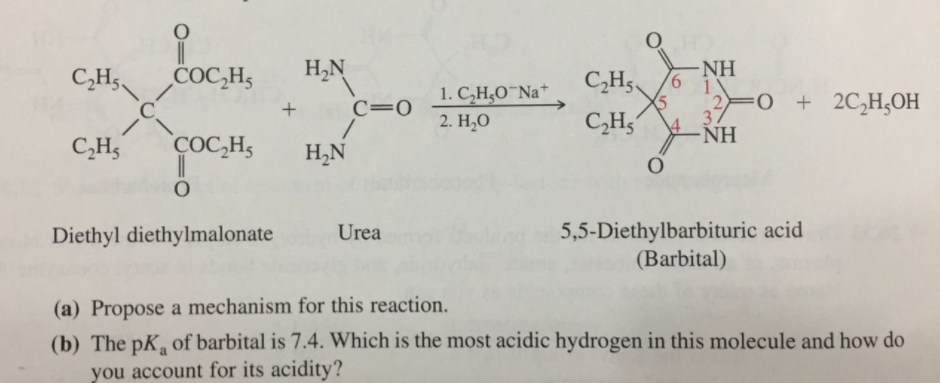H,N NH COC,H; C. C,H5. 1. C,H,O¯N * 2. H,0 9. 2) \4. C=0 O + 2C,H;OH C,H, NH C,H; COC,H, H,N 5,5-Diethylbarbituric acid (Barbital) Diethyl diethylmalonate Urea (a) Propose a mechanism for this reaction. (b) The pK, of barbital is 7.4. Which is the most acidic hydrogen in this molecule and how do you account for its acidity?
H,N NH COC,H; C. C,H5. 1. C,H,O¯N * 2. H,0 9. 2) \4. C=0 O + 2C,H;OH C,H, NH C,H; COC,H, H,N 5,5-Diethylbarbituric acid (Barbital) Diethyl diethylmalonate Urea (a) Propose a mechanism for this reaction. (b) The pK, of barbital is 7.4. Which is the most acidic hydrogen in this molecule and how do you account for its acidity?
Chemistry
10th Edition
ISBN:9781305957404
Author:Steven S. Zumdahl, Susan A. Zumdahl, Donald J. DeCoste
Publisher:Steven S. Zumdahl, Susan A. Zumdahl, Donald J. DeCoste
Chapter1: Chemical Foundations
Section: Chapter Questions
Problem 1RQ: Define and explain the differences between the following terms. a. law and theory b. theory and...
Related questions
Question
- Barbiturates are prepared by treatment of diethyl malonate or a derivative of diethyl malonate with urea in the presence of sodium ethoxide as a catalyst. Following is an equation for the preparation of barbital, a long-duration hypnotic and sedative, from diethyl diethylmalonate an urea. Barbital is prescribed under one of a dozen or more trade names.
- Propose a mechanism for This reaction
- The pKa of barbital is 7.4. Which is the most acidic hydrogen in this molecule and how do you account for its acidity?

Transcribed Image Text:H,N
NH
COC,H;
C.
C,H5.
1. C,H,O¯N *
2. H,0
9.
2)
\4.
C=0
O + 2C,H;OH
C,H,
NH
C,H;
COC,H,
H,N
5,5-Diethylbarbituric acid
(Barbital)
Diethyl diethylmalonate
Urea
(a) Propose a mechanism for this reaction.
(b) The pK, of barbital is 7.4. Which is the most acidic hydrogen in this molecule and how do
you account for its acidity?
Expert Solution
This question has been solved!
Explore an expertly crafted, step-by-step solution for a thorough understanding of key concepts.
This is a popular solution!
Trending now
This is a popular solution!
Step by step
Solved in 2 steps with 3 images

Knowledge Booster
Learn more about
Need a deep-dive on the concept behind this application? Look no further. Learn more about this topic, chemistry and related others by exploring similar questions and additional content below.Recommended textbooks for you

Chemistry
Chemistry
ISBN:
9781305957404
Author:
Steven S. Zumdahl, Susan A. Zumdahl, Donald J. DeCoste
Publisher:
Cengage Learning

Chemistry
Chemistry
ISBN:
9781259911156
Author:
Raymond Chang Dr., Jason Overby Professor
Publisher:
McGraw-Hill Education

Principles of Instrumental Analysis
Chemistry
ISBN:
9781305577213
Author:
Douglas A. Skoog, F. James Holler, Stanley R. Crouch
Publisher:
Cengage Learning

Chemistry
Chemistry
ISBN:
9781305957404
Author:
Steven S. Zumdahl, Susan A. Zumdahl, Donald J. DeCoste
Publisher:
Cengage Learning

Chemistry
Chemistry
ISBN:
9781259911156
Author:
Raymond Chang Dr., Jason Overby Professor
Publisher:
McGraw-Hill Education

Principles of Instrumental Analysis
Chemistry
ISBN:
9781305577213
Author:
Douglas A. Skoog, F. James Holler, Stanley R. Crouch
Publisher:
Cengage Learning

Organic Chemistry
Chemistry
ISBN:
9780078021558
Author:
Janice Gorzynski Smith Dr.
Publisher:
McGraw-Hill Education

Chemistry: Principles and Reactions
Chemistry
ISBN:
9781305079373
Author:
William L. Masterton, Cecile N. Hurley
Publisher:
Cengage Learning

Elementary Principles of Chemical Processes, Bind…
Chemistry
ISBN:
9781118431221
Author:
Richard M. Felder, Ronald W. Rousseau, Lisa G. Bullard
Publisher:
WILEY